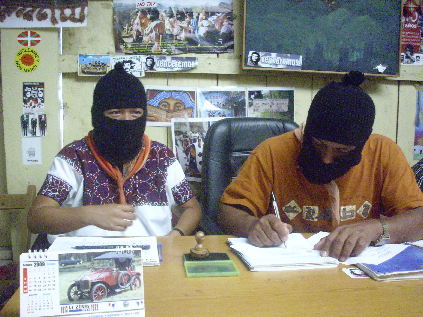“So, why are you here?” asked the four masked rebels, in broken Spanish. Indeed, what exactly was I doing, deep in Zapatista territory in what is generally described as a low-intensity warzone? Sixteen years on from the Zapatista uprising, I had come to find out if the 'revolution' was still alive.
The Zapatista movement has faded from the headlines in recent years; the mainstream Mexican media ignoring it, while the government encourages tourism in Chiapas as if the 'problem region' no longer exists. During the 2006 Presidential Elections, the Zapatistas launched La Otra Campaña (The Other Campaign), an attempt to create unity with like-minded organisations and subjugated Indigenous groups elsewhere in Mexico. Yet the campaign was met with an underwhelming response, and the government brutally crushed two of the Zapatistas’ biggest support bases in Oaxaca and Atenco.
Going Native - The Zapatista School for Tourists
I enrolled for two weeks in the Zapatistas’ autonomous language school in Oventic. Squashed in a battered combi, we rattled along the winding mountain road for about an hour before reaching Oventic, the largest and most accessible of the Zapatista caracoles. Its idyllic setting does little to dissuade visitors from romanticising the place. This humble community sits deep in the mountains amidst tranquil pine forests. Farmyard animals wander freely among the wooden huts, all beautifully adorned with elaborate murals. Some days heavy fog comes rolling in to engulf the entire community. They say the mist is the balaclava of the mountains, for it provides the rebels with brief moments of respite from military surveillance.
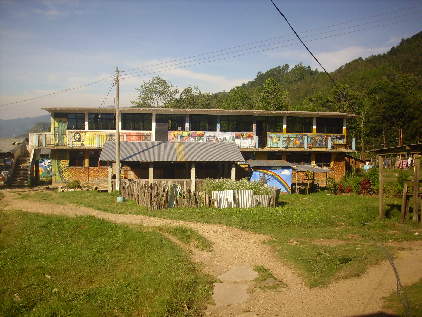
In recent years the Zapatistas have welcomed foreign sympathisers to study in Oventic. The school is a vital tool for protecting Indigenous language and culture from globalisation, but also for building worldwide solidarity. As one of the teachers observes, “The government wants to separate us, but the only way we have strength is by connecting with each other.”
From here I also visited the nearby autonomous municipality of Magdalena de la Paz. The people there still live in real poverty, and the community is divided between Zapatistas and those who support the Institutional Revolutionary Party (PRI) that ruled Mexico for over 70 years. In the surrounding areas the government is building Orwellian-sounding “rural cities” - in an effort to tempt the Indigenous campesinos to abandon their villages, forget their culture and assimilate into the neoliberal labour market. This is just the latest development in the government’s long-running campaign to undermine the Zapatista movement.
Land and Liberty - A Bit of History
The 1st January 1994 was the day that the North American Free Trade Agreement (NAFTA) came into effect. It was also the date that the Zapatista Army of National Liberation (EZLN) chose to rise up in arms, briefly seizing a number of major cities in the southern state of Chiapas.
“¡Ya Basta!” (Enough!) was their war cry. For under NAFTA the distribution of land guaranteed by Article 27 of the Constitution was to be erased. Suddenly the major gain of the Mexican Revolution, for which thousands of Indigenous had fought and died, was now being sold out to the highest foreign bidder.
In reality the EZLN were a small, poorly-equipped guerrilla force; their real power lay in the huge support they drew from civil society, with hundreds of NGOs, charities, activists and academics all rallying behind the Zapatista cause. Arriving as it did in the early 1990s, it was also the first such movement to capture the potential of the internet. New media enabled the Zapatistas to build international networks of support by bypassing the traditional channels of communication and directly presenting their struggle to the world, free from media distortion.
“There is no theory, Zapatismo is a practice” a compañero informs me. The Zapatista movement marked a break from previous Left-wing guerrilla insurgencies. Rather than attempting to seize power, the Zapatistas begun to build their own autonomous society within the state. “This space right here is another world that we’re constructing; it’s a gateway,” I am told. “We are not alone; we’re together in solidarity with many others who want to change the world. This is the idea of our space here: it’s a place to share ideas. This way we can achieve something big.”
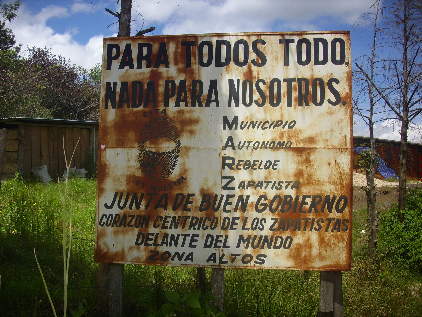
Unsure of what to make of this internet-savvy, post-communist insurgency, journalists were soon falling over themselves to describe it as “the world’s first post-modern revolution.” This was at best a superficial analysis; one which ignores the root causes of the conflict: the centuries of discrimination and marginalisation of the Indigenous population.
Chiapas is paradoxically Mexico’s poorest state, yet the richest in natural resources. The majority lived in extreme poverty: often without healthcare, education, electricity or even water. Having lost their rights to land on top of all this, the Indigenous population were left with few remaining options. The Zapatista uprising was a desperate people’s response to the intolerable circumstances to which they had been condemned.
For many, the Zapatista movement is but the latest phase in a long tradition of resistance. “The struggle always comes from the Indigenous people” asserts a proud Tzotzil Indian. “We have a culture of rebellion.” The Mayans from Chiapas and the Yucatan fiercely resisted the Spanish conquistadors for nearly a hundred years after the Aztecs were defeated. The south also produced Emiliano Zapata, the campesino hero of the Mexican Revolution from whom the Zapatistas take their name.
So the South's latest hero came in the form of EZLN's enigmatic media spokesman , Subcomandante Marcos, the charismatic figure forever hidden behind his trademark pipe and balaclava. Unlike his Indigenous compañeros, Marcos was a well-educated mestizo and a former University professor. Witty and poetic in his communiqués, Marcos steeped himself in symbolic imagery and quickly assumed the profile of a rock star revolutionary. The media loved him. Here was an anonymous Che Guevara for the 21st Century, standing up for Indigenous rights against a corrupt government backed by corporate America.

After the Revolution- Governing from the Left and Below
Initially, forced to respond to Zapatista demands, in 1996 both parties signed the San Andrés Accords, a compromise peace settlement which dealt with most of the Zapatista demands, granting autonomy, rights and recognition to Mexico’s Indigenous population.
However, President Zedillo rejected these terms and stepped up counter-insurgency military operations whilst negotiations were still ongoing. The government has never fulfilled its obligations, leaving the Zapatistas to unilaterally implement the Accords. Despite the fall of the PRI in 2000, Mexico’s three major political parties made a tacit agreement to ignore any further demands, causing the Zapatistas to withdraw from all official dialogue with Mexico’s politicians.
The government's current policy towards is one of containment and denial. But where has this left the Zapatista revolution on the ground? Rejecting the representative democracy of the western world, the Zapatistas govern from below in a system of participatory democracy. The Juntas de Buen Gobierno are locally appointed governing councils which rotate every couple of weeks, ensuring that everyone has a say and that all decisions meet the agreement of the community.
After a fairly intimidating reception from the balaclava-clad Junta, the people I met proved to be friendly and welcoming. The living quarters were rustic to say the least. I was staying in a sparse dorm in which I found myself fighting off nightly invasions by marauding cockroaches. It was bitterly cold at night. But there was no sense of staying in a battle zone. In fact I didn’t see a single weapon on display in the entire caracol. Paradoxically, since the initial uprising in 1994, this has been an armed movement entirely reliant upon non-violent tactics.
Each caracol has its own health clinic and primary school, for the use of inhabitants from the surrounding municipalities. The Zapatistas have rejected any form of state funding in their communities, considering it a threat to their autonomy. State handouts are seen as but another means of control, making the Indigenous communities reliant on the scraps that the authorities toss them. “They throw us the crumbs but we don’t accept it. If we organise ourselves we don’t need government aid” proclaims a defiant teacher from Oventic.
Aside from rather basic toilets and washing arrangements, the general facilities were of a much higher quality than I had expected. Alongside its primary and secondary schools, Oventic boasts a language centre for foreign students, where I met a group of nineteen Swedes during my second week of classes. In addition there is the all important basketball court; a boot factory; several small shops selling basic supplies and local artisan produce; farmlands where they grow their own food and coffee; and a health clinic which the aforementioned Swedes would come to know very well indeed. The food each day was simple vegetarian cuisine, accompanied by warming mugs of chocolate, tea or home grown coffee. However, life seemed a lot tougher in Magdalena de la Paz, and I felt fortunate there to be offered the luxury of eggs alongside the staple meal of beans and tortillas.
It proved difficult for western stomachs to acclimatise to the local rations, and over half of the Swedes had been consigned to the health clinic by the end of their first week (ironically a planned trip to visit the clinic had to be cancelled due to the number of people ill). The Swedes were misdiagnosed with Salmonella by the local doctor, suggesting that Zapatista healthcare still has some way to go. Yet its mere existence is a huge and vital achievement for those who live in the surrounding areas.
"Lento, Pero Avanzo"
It comes as no surprise that nothing here has been perfected. The Zapatista movement has been hampered by considerable and persistent government oppression, but continues moving forward. Rejecting the lead of the Black Panthers and the Tamil Tigers, the Zapatistas liken themselves not to the Jaguar Warriors of their ancient ancestors, but to that fierce and deadly predator, the snail.
“Lento, pero avanzo” (Slow, but advancing) boasts a snail in one of Oventic’s many murals. It may not be the most inspiring metaphor, but its message is clear: despite their slow pace, the Zapatistas are still steadily advancing. Progress in fields such as education is already evident. “Our parents didn’t know how to read or write” one of the teachers tells me, “we are advancing with every generation, and we are only just beginning.” Aware that they are part of a long history of struggle, The Zapatistas are in this for the long haul.
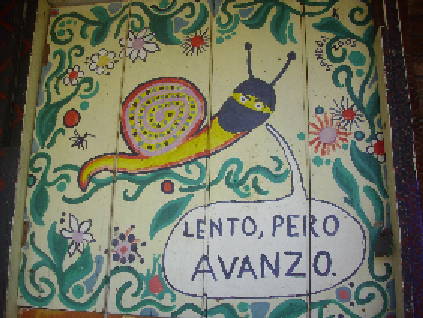
As the poorest demographic in Mexico, the Zapatistas are fiercely opposed to the capitalist system that drives the exploitation of their people. “The poor have the mission to change the world, and so the rich are afraid of us... but we are happy, we are the heart and soul of humanity.” But the Zapatistas are trying to reach out beyond those at the bottom, urging the civil society that has always professed support for them to actually take action itself.
“These are urgent times. Capitalism is in its moment of crisis” declares a young rebel. “The middle classes are being exploited too, although they might not always realise it. (In order to succeed) we need each other. Everyone must do something in their own place, besides simply helping those at the bottom.”
Although perhaps leaning a little too heavily on the side of ideological indoctrination, the Zapastistas’ autonomous education programme has been instrumental in keeping their movement alive. From my observation, it has clearly restored the dignity of the Indigenous population, and given their lives real purpose beyond the daily struggle to get by.
“Low Intensity” War Zone and the Uphill Battle.
Despite The Zapatistas determination to create the world they want and live in dignity, they are facing an uphill battle against President Calderon’s militarisation of the Mexican state under the pretext of the War on Drugs: “In reality the government doesn’t have the intention of fighting drug-trafficking, but of fighting the people. If ten people die everyday, this is normal now. We’re living in an extraordinary situation,” the balaclava-clad men tell me. Since his disputed election in 2006, Calderón has used the War on Drugs as a central strategy to legitimise his Presidency. But the Zapatistas, among others, believe that he is working with certain cartels whilst merely attacking their rivals.
The increased militarisation of the country is all too apparent. In the past few months I’ve driven through too many army checkpoints to even begin to count. Yet despite the incredible levels of violence in the north, one third of Mexico’s armed forces remain stationed down in Chiapas. There are over 70,000 soldiers in the state, highly concentrated around Zapatista-controlled areas. Additionally, the government has hired, armed and trained around a dozen paramilitary groups to do their dirty work for them.
Those living in autonomous communities are routinely displaced from their villages, while violence has become a daily occurrence throughout Chiapas and the surrounding areas. Zapatista supporters, Otra Campaña affiliates, and even human rights observers are victims of daily harassment, be it in the form of threats, beatings, murder or sexual assault. “They don’t want us, the indigenous people, to exist. They only want us to suffer more. The presidents and governments in Mexico have always had this idea” complains an indignant Zapatista woman.
The current situation is untenable. The Zapatistas may be patiently building for the future, but conditions today are arguably worse than they were in 1994. A keen follower of the movement, Noam Chomsky informed me that he “was in Mexico City recently and spoke to journalists and activists who have been fairly closely involved. They expect something significant to surface soon, but are not sure what.”
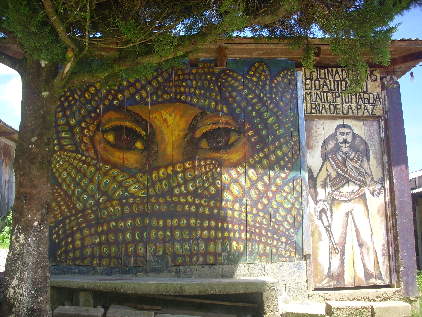
Bi-centenary - a Reason to Celebrate?
2010 is a year of huge significance in Mexican history, marking the hundredth anniversary of the Mexican Revolution and the bicentenary of Independence from Spain. The Zapatistas have a penchant for symbolic dates, and it remains to be seen whether history will repeat itself. The caracol remains awash with fighting talk: “This is a rebellion; it’s more than just resistance. We don’t merely want to survive; we want to transform the world.”
“It looks like nothing is happening, but it’s there, beneath the surface. There is coordination. No one knows what’s going to happen. It’s a mystery,” is the intriguing response to my query on future action. “Marcos is no longer seen in public, but when everyone is ready, we’ll see what the next step is... The people are preparing, but so is the government. They want a civil war, so that they have an excuse to eliminate us.”
It is a true Mexican standoff. Both sides are cautiously awaiting the next move. It may appear subdued, but behind the scenes the movement lives. Dark clouds are gathering over Chiapas and Mexico’s future looks turbulent. Despite the government’s best efforts, the final chapter of the Zapatista struggle has yet to be written.
My time here has assuaged any doubts: the people’s spirit remains intact. Zapatismo is a unique and inspiring social experiment, which has survived in the most adverse of circumstances. It may be flawed and pragmatic, but away from the media lens, it continues advancing steadily, like the snail.


